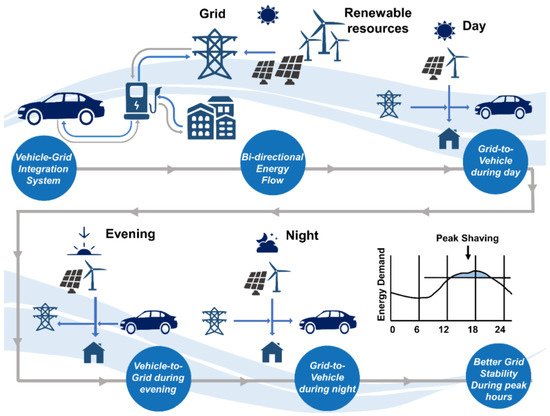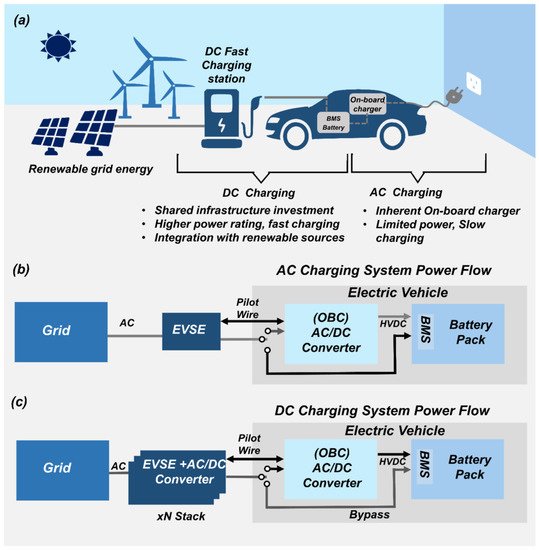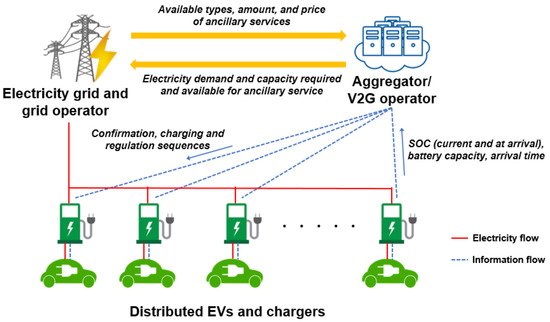With every passing second, we witness the effect of the global environmental impact of fossil fuels and carbon emissions, to which nations across the globe respond by coming up with ambitious goals to become carbon-free and energy-efficient. At the same time, electric vehicles (EVs) are developed as a possible solution to reach this ambitious goal of making a cleaner environment and facilitating smarter transportation modes. This excellent idea of shifting towards an entirely EV-based mobility industry and economy results in a range of issues that need to be addressed. The issues range from ramping up the electricity generation for the projected increase in consumption to developing an infrastructure that is large enough to support the higher demand for electricity that arises due to the market penetration of EVs. Vehicle to grid (V2G) is a concept that is largely in a testing phase in the current scenario. However, it appears to offer a solution to the issues created by a mobility sector that the constantly growing EV fleet will dominate. Furthermore, the integration of EVs with the grid seems to offer various cost-wise and environment-wise benefits while assisting the grid by tapping into the idle energy of parked EVs during peak hours
- electric vehicle
- vehicle-to-grid
- ancillary service
- aggregation
1. Introduction
Managing the charging patterns of EVs is considered a crucial step for the penetration of EVs in the global markets since it strongly affects the quality of transmission through the electrical grids. The IEA has also predicted that in 2030, there will be a significant rise in electricity demand, especially during the evening hours, while attributing this spike in demand to unmanaged and concentrated EVs charging. This demand is estimated to be around 5.5% for the US, 6.5% for the EU, and 9.5% for China [2]. Furthermore, through appropriate management and control, it is possible to tap into the massive battery reserves of EVs for utilization in other secondary applications, especially when EVs are connected to the electrical grid.
The term vehicle-grid integration (VGI) is a broader term or a concept that hints at a possible synergistic utilization of both the grid-to-vehicle (G2V) and V2G systems. While the former refers to the flow of electricity from the grid to EVs (which would be the case during charging), the latter facilitates the flow of electricity from EVs to the grid (discharging, electricity return). It is also helpful to note at this point that V2G as a term has been used synonymously with that of VGI to mean the flow of electricity in both directions (both from and to the grid).
An illustration of the V2G, or in general as VGI, concept during different times of the day is presented in Figure 1. This review aims to provide a comprehensive picture of the present developments with EV and grid integration while also throwing light on the possible ancillary services that could be made available due to V2G while also showing the possible room for economic developments and business opportunities that arise with an increasing number of global electric vehicle fleets and the impact and challenges, they pose in various aspects, such as the economic, environmental and technological fronts.

Figure 1. An illustration of the V2G concept during different times of the day. The graph shown in the figure is only for illustrative purposes (redrawn from [7]).
2. V2G System and Infrastructure
2.1. System Architecture
The system architecture associated with V2Gs can be classified into centralized and decentralized architectures. In a centralized architecture, the aggregator is the primary component for handling all the charging and discharging phenomena of EVs. In addition, the aggregator can also perform optimization for smart charging of the EVs: hence, it may have access to the system data whenever necessary. These features serve to organize the distribution, increase the system capacity, and provide ancillary services. However, this also means that the system has a huge quantum of data to process and optimize, such as the preferred level of SOC, available battery size, charging time, and many more to arrive at the most optimum solution [38]. Frequency control also becomes complicated with a centralized control architecture, since controlling is difficult when different vehicles are at different states of charge, and this could often be coupled with the uncertainty of EVs at the charging stations. Most literature, for this reason, dives deeper into the prospects of a decentralized or a local control architecture [39].
2.2. Charging System
V2G involves two main types of charging systems: AC and DC charging systems. While the AC charger charges the battery via the vehicle’s on-board charger, the DC charger directly charges the vehicle’s battery using an AC-DC converter on the charger side, as shown in Figure 2a. Before diving into the details of how the AC and DC charging works and why it is used, it is important to understand what an on-board and off-board charger are all about. An on-board charger is primarily responsible for charging the battery pack during its final stage. It utilizes the AC power source from the electric vehicle supply equipment and converts this power into the required battery-charging profile (typically in high-voltage DC). While the on-board charger’s primary role is to transform power from the off-board charger before supplying to the battery management system (which often is abbreviated as BMS—an electronic system that manages/protects the battery by operating it within a safe operating region and controlling its environment), the off-board charger has the ability to work without an on-board charger and is interfaced directly with the battery management system [43].

Figure 2. Conceptual diagram of V2G enabled charging system: (a) Differences between AC, DC charging and on-board charger (b) Level 1 and Level 2 AC charging stations and (c) Level 3 DC charging station (fast charging) (redrawn from [44]).
2.2.1. Uni-Directional Charger
When EVs are integrated with a grid, they serve as either a load or a distributed storage device to power and support the grid. Uni-directional chargers can only charge the EVs from the grid but cannot redirect the power to the grid when needed. Various studies are currently in progress on optimizing uni-directional charging to yield the most benefits for EV owners, aggregators, and grid operators [45,46]. Most of the utility objectives that arise with EVs can be addressed with uni-directional charging, even if there is a higher level of EV penetrations in the market while avoiding many major issues, such as equipment cost, system performance, and safety associated with bi-directional chargers [47,48]. This way of charging adds to no additional cost for implementation while also preventing the degradation of the battery life due to high charging and discharging cycles [49].
2.2.2. Bi-Directional Charger
V2G requires a bi-directional system to deliver electricity from the grid to EVs’ batteries, and vice versa. This bi-directional system can be facilitated using double uni-directional or single bi-directional converters [52,53]. However, utilization of double uni-directional converters (chargers) means a higher total cost, heavier weight, and larger dimensions. Therefore, bi-directional converters (chargers) and the advanced development of solid-state technology lead to optimum techno-economic benefits.
A bi-directional AC-DC converter facilitates both AC-DC power conversion and power factor correction. EVs with bi-directional chargers can achieve various features due to the nature of the power flow both off and to the grid, which is popularly termed V2G. When the batteries of EVs are idle but still connected to the grid, they can provide energy to the grid when the demand is high, enhancing the grid efficiency [54,55,56]. Also, bi-directional charging plays a key part in integrating RES with the grid [57,58]. While bi-directional charging aids in voltage regulation, recurrent charging and discharging (cycling) of the battery causes battery degradation, which finally affects the battery life. Another issue with bi-directional charging is the additional cost involved with its infrastructure. Additionally, customer acceptance and secure two-way communication networks impede the market penetration of bidirectional chargers [51,59,60,61].
2.3. Communication System
Communication between the grid and the EVs to transfer the data (e.g., travel, battery, EVs conditions) and decide the charging mode results in a complex communication structure [62]. Seamless communication is a prerequisite to designing a charging station network [63]. Various communication schemes and strategies have been proposed to avoid compatibility issues within the charging station network. [64,65,66,67]. Also, to avoid this scenario, specific standards have been established that must be complied with by the manufacturing companies. Standards have been set for EVs in four levels of the V2G technology, which are the plug, communication network scheme, charging topology, and safety standards.
2.4. Aggregator
An aggregator must be able to participate in the electricity market through different ancillary services of the grid by organizing and optimizing the EVs charging and managing the load profile [72]. A simplified architecture of the V2G system highlighting the role of an aggregator is shown in Figure 3. A little consideration will show that the aggregator plays as an interface between EV fleets and grid operators. In the first step of the process, the aggregator will establish a connection to each vehicle in the EV fleet, which has a service contract with the aggregator to utilize its battery, based on its current SOC to participate in ancillary services to the grid. Data from the EV will pass on the parameters required by the aggregator, with the condition for participation in this V2G system being that the EV sufficiently charges during the plug-out time. However, it should be noted that if the EV driver does not abide by the contract and drives away before the pre-notified departure time, the battery may not be sufficiently charged at time of the plug-out. Since the aggregator deals with thousands of vehicles at a time, the fraction of vehicles departing before the pre-notified time will remain constant and is negligible when considering the regulation process [72].

Figure 3 A simplified data flow and architecture of the V2G system highlighting the role of an aggregator.
3. Business Model and Power Market
From a power grid point of view, the charging of EVs can be considered an additional load to the grid. The increase and concentrated charging will need an additional generation of grid power, which is bound to increase the system cost and the cost of the power consumed. Furthermore, the current grid infrastructure will suffer losses through energy transmission with the increased EV penetration. Only through smart controlled charging can the cost of power consumed be reduced to about 60% [91,92].
When comparing the revenues generated by the V2G services with the investment costs, we find that the investment costs far outweigh the revenues generated from the V2G. Even if one tends to ignore the substantial investment costs, the opportunity costs that arise from not charging the vehicles at the parking facilities will outweigh possible revenues obtained by V2G ancillary services, especially frequency regulation.
A study conducted by Brandt et al. [93] discusses that even if a market environment appropriate for the V2G were present, the technology would not be feasible since high market prices for regulation are required to make up a viable model for business. The study goes on to suggest that just because V2G is a technically feasible concept does not make it an economically viable option. If this were the case, the increasing market penetration of EVs needs to be given more careful consideration with respect to the grid infrastructure that we currently have today. Be that as it may, it is also projected that the global V2G market size is projected to reach 28.12 billion USD by 2026, with a compounded annual growth rate of around 4.28% between 2021 to 2026 [94].
4. Conclusion:
Careful consideration into some of the issues that were discussed above regarding V2G can be briefly summarized as follows:
- Huge steps towards infrastructural developments in terms of charging stations, charging and discharging protocols, security protocols, and standardization become quintessential. They need to be developed alongside EV technology to avoid over-whelming the current unprepared grid infrastructure.
- Government policies, incentives, and support that are provided initially to boost a transition towards EVs might not be sustainable. In addition, a collective increase in acceptance of the technology leading to mass production might make the technology more economically viable to the consumer.
- The social and market acceptability of a technology that is different from a conventional way is an issue that needs to be addressed.
- Since most vehicle grid integration-based studies are simulation-based and the lack of large-scale demonstration of the technology, it is quite uncertain to predict/forecast the economic feasibility of this technology at this point with the current market conditions and current technological developments.
- Small-scale demonstration and simulation-based studies suggest technical viability, which need not necessarily translate into economic viability.
This entry is adapted from the peer-reviewed paper 10.3390/en15020589
